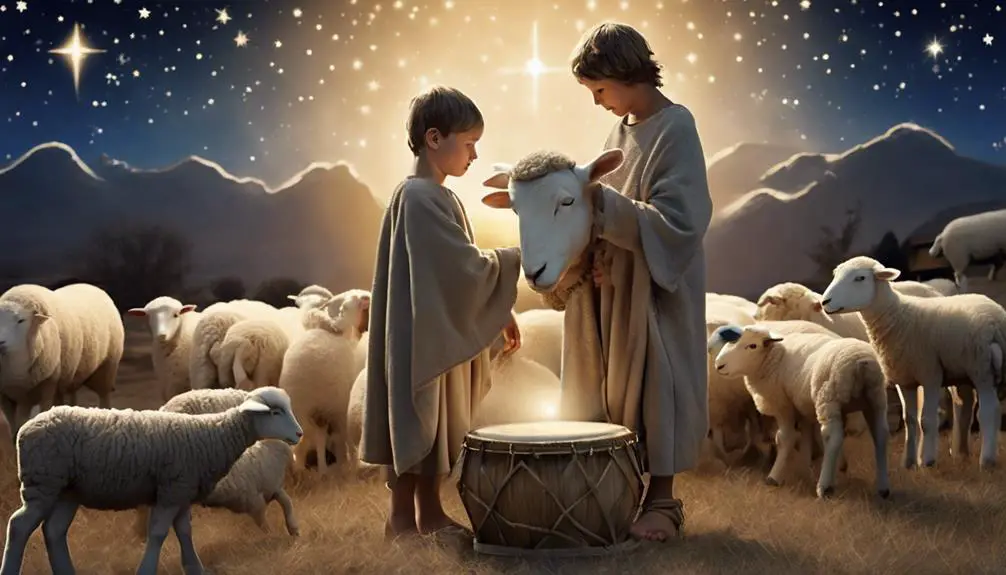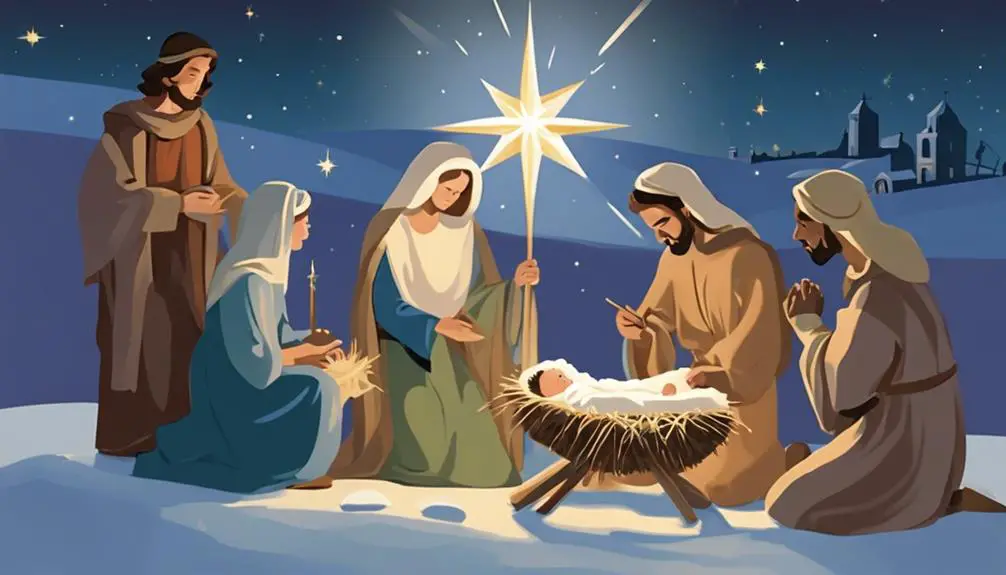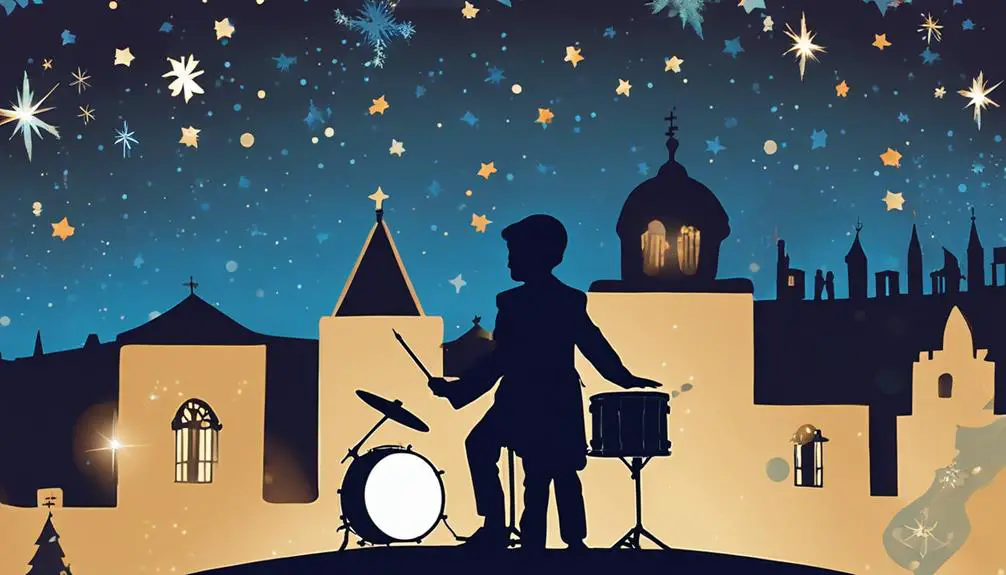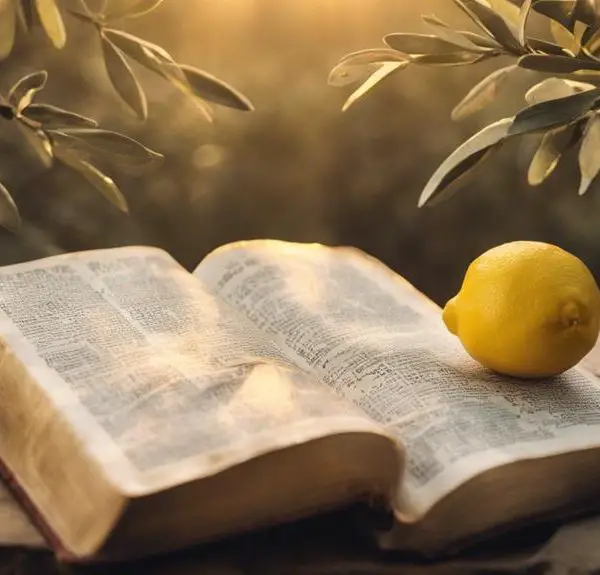Marvel at the mystery of the Drummer Boy's biblical existence and uncover the truth behind this cherished Christmas legend.

Is the Drummer Boy in the Bible
You've likely hummed the harmonious hymn of the 'Little Drummer Boy' during the holiday season, but have you ever pondered its presence in biblical texts? This question invites you to explore the origins of this beloved character and examine whether he marches through the pages of Scripture or if his story stems from modern traditions.
By analyzing scriptural evidence and reflecting on the interplay between myth and faith, you'll discover intriguing insights into how and why certain narratives capture our collective imagination. Let's embark on a journey to uncover the truths and tales behind the drummer boy's enduring legacy.
Key Takeaways
- The Drummer Boy story does not originate from biblical accounts but from creative cultural interpretations.
- No scriptural evidence in the Gospels of Matthew and Luke supports the existence of a Drummer Boy at Jesus' birth.
- The Drummer Boy narrative has become a symbolic part of modern Christmas traditions, despite its absence in biblical texts.
- The story's significance lies in its themes of humility and offering, echoing universal values rather than historical or scriptural accuracy.
Biblical Accounts of Jesus' Birth

The biblical accounts of Jesus' birth, primarily found in the Gospels of Matthew and Luke, offer distinct narratives that have been the subject of scholarly analysis for centuries. You'll notice that each Gospel emphasizes different elements of the story, contributing to a rich tapestry of the Nativity scene that has captivated imaginations across generations.
In Luke's account, the Shepherds' visit stands out as a significant event. It's depicted as a humble yet profound acknowledgment of Jesus' birth, with angels announcing the news to shepherds in nearby fields. This visit signifies the importance of Jesus' arrival to all social strata, especially the marginalized.
Conversely, Matthew's narrative introduces the Star of Bethlehem, a celestial event that guides the Magi, or Wise Men, to Jesus. This element has intrigued scholars and astronomers alike, sparking debates about its historical and astronomical accuracy. The Star of Bethlehem not only signifies divine intervention in the natural world but also marks Jesus' birth as an event of cosmic significance.
Both narratives, with their unique elements, underline the multifaceted nature of the Nativity story, inviting continuous exploration and interpretation.
Origins of the Drummer Boy Story

While the biblical accounts provide rich narratives of Jesus' birth, the story of the Drummer Boy, popular in modern Christmas lore, doesn't find its roots in these sacred texts. Instead, its origins can be traced back to a blend of musical history and cultural interpretations that have evolved over centuries. The tale, as known today, emerged from the creative minds of songwriters, rather than ancient religious scripture or historical documentation.
The concept of a young boy playing his drum for the newborn king encapsulates the universal themes of humility, innocence, and the offering of one's best gifts, regardless of their material worth. These themes resonate deeply within the human psyche, contributing to the story's widespread appeal and integration into Christmas traditions around the world.
Analyzing the story from a musical history perspective reveals its relatively recent addition to the canon of holiday folklore, highlighting how cultural interpretations can shape and enrich traditional narratives. The Drummer Boy's story is a testament to the power of music and storytelling in forging emotional connections and fostering a sense of communal identity, especially during the season of giving and reflection.
Analyzing Scriptural Evidence

Delving into biblical texts, it's clear that no scriptural evidence directly supports the existence of a Drummer Boy at the birth of Jesus, highlighting the story's folklore origins rather than a biblical basis. The narratives found in the Gospels of Matthew and Luke, which provide the most detailed accounts of Jesus' birth, make no mention of a young boy playing a drum or any specific individual offering a musical tribute. Instead, these accounts focus on the visitation by shepherds and magi, without reference to musical instruments or performances.
This absence is significant when considering the role of musical instruments in biblical times. Instruments such as lyres, harps, and trumpets are mentioned in various contexts throughout the Bible, underscoring their importance in worship and celebrations. However, the specific image of a drummer boy, as popularized in modern retellings, lacks scriptural backing.
The evolution of the Drummer Boy narrative can be attributed more to cultural interpretations and storytelling traditions than to any biblical account. This distinction is crucial for understanding the story's place within the wider context of Christmas lore, separating scriptural fact from festive fiction.
The Drummer Boy in Modern Traditions

Despite the lack of scriptural evidence, the Drummer Boy has embedded himself into modern Christmas traditions, reflecting a complex interplay of cultural narratives and festive spirit. You've likely noticed his presence in a myriad of Christmas carols, each telling the story of a young boy who played his drum for the newborn king. These songs, often played during holiday parades and festive gatherings, underscore the Drummer Boy's symbolic significance in contemporary celebrations.
Delving deeper, the Drummer Boy's inclusion in modern traditions underscores a broader cultural phenomenon. It's a testament to how folklore and religious narratives can merge, creating a tapestry that enriches holiday observances. The character has become a fixture in holiday parades, embodying the joy and simplicity of the season. Through these parades, communities across the globe embrace the story, regardless of its non-biblical origins, highlighting a universal desire to connect through stories of hope and giving.
This integration into festive traditions isn't merely about entertainment; it's a reflection of society's collective imagination and its power to adopt and adapt narratives, enriching the fabric of holiday celebrations. The Drummer Boy, thus, serves as a symbol of cultural synthesis, illustrating how folklore can weave itself into the heart of modern festivities, bridging gaps between myth and tradition.
Reflections on Myth and Faith

The intertwining of myth and faith in holiday traditions invites a nuanced examination of their impact on cultural and religious practices. You're invited to explore how stories like that of the drummer boy, while not found in biblical text, play a significant role in shaping the collective memory and understanding of religious narratives. Through this lens, the quest for historical authenticity becomes secondary to the cultural interpretations that these myths foster.
Emotion |
Description |
|---|---|
Joy |
The drummer boy story brings joy, embodying the spirit of giving and the innocence of childhood. |
Nostalgia |
This myth evokes a longing for simpler times, connecting individuals to their cultural heritage. |
Reflection |
It prompts introspection on the values celebrated during the holidays—kindness, generosity, and peace. |
Unity |
The story unites people across different faiths and cultures, highlighting shared human values rather than differences. |
Analyzing these emotional responses reveals the profound impact myths can have on faith and cultural traditions. They enrich the tapestry of religious observance, offering a broader understanding that transcends historical facts. This exploration underlines the importance of myths in shaping and expressing collective identities, urging a reevaluation of their role within the framework of faith and culture.
Frequently Asked Questions
How Has the Depiction of the Drummer Boy Evolved in Visual Arts Throughout History?
You've noticed that the depiction of the drummer boy has undergone significant transformations in visual arts. Initially symbolizing martial valor, artistic interpretations gradually infused this figure with innocence and peace. This evolution reflects shifting societal values and the complex layering of drummer symbolism.
Are There Any Known Traditional or Folk Songs From Ancient Cultures That May Have Inspired the Drummer Boy Narrative?
You're exploring whether ancient cultures have traditional or folk songs that might've inspired the drummer boy narrative.
Musical archaeology suggests that cultural transmission played a key role in this.
As you delve deeper, you'll find that rhythms and themes from old war and festival songs likely influenced the story.
This scholarly journey into the origins of these narratives reveals how deeply intertwined music and cultural stories are, offering fascinating insights into our past.
How Do Different Christian Denominations View the Inclusion of Fictional Elements, Like the Drummer Boy, in Christmas Celebrations?
How do you reconcile the charm of tradition with the demands of historical accuracy and cultural appropriation?
Different Christian denominations vary in their views on fictional elements like the Drummer Boy in Christmas celebrations. Some see it as a harmless embellishment that enriches the festive spirit, while others argue it blurs the lines of historical accuracy and could veer into cultural appropriation.
Ultimately, the acceptance hinges on each denomination's emphasis on scriptural fidelity versus cultural engagement.
What Psychological Impacts Might the Story of the Drummer Boy Have on Children's Understanding of Their Role in Religious or Spiritual Practices?
The story of the Drummer Boy might significantly influence your understanding of participation in spiritual practices.
From a child psychology perspective, it teaches you that gifts of the heart hold immense value, fostering a sense of belonging and contribution to one's faith community.
This narrative can play a crucial role in your spiritual development, emphasizing that personal offerings, regardless of their material value, are precious and meaningful in religious or spiritual contexts.
Has the Drummer Boy Story Been Adapted or Referenced in Other Religious Traditions or Ceremonies Outside of Christianity?
You might wonder how the tale of a drummer boy resonates beyond its origins. While primarily rooted in Christian lore, its drummer symbolism and cultural adaptations have found echoes in other religious traditions and ceremonies.
Analyzing these narratives, it's clear they serve as a bridge, connecting diverse faiths through shared themes of hope and sacrifice. This cross-cultural journey showcases the story's universal appeal, transcending its initial context to inspire a wider audience.
Conclusion
In conclusion, while the drummer boy's presence isn't chronicled in the sacred texts, this narrative has nestled itself into contemporary celebrations, serving as a testament to the human penchant for embellishment. Through scholarly analysis, it's clear this figure is a fabrication, a creative addition rather than a historical account.
Yet, this doesn't diminish its value. Instead, it enriches our festive traditions, illustrating how myth and faith can intertwine to deepen the tapestry of cultural and religious observance.



Sign up